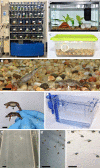Amphibian Hymenochirus boettgeri as an experimental model for infection studies with the chytrid fungus Batrachochytrium dendrobatidis
- PMID: 37823610
- PMCID: PMC10614710
- DOI: 10.1080/21505594.2023.2270252
Amphibian Hymenochirus boettgeri as an experimental model for infection studies with the chytrid fungus Batrachochytrium dendrobatidis
Abstract
Model organisms are crucial in research as they can provide key insights applicable to other species. This study proposes the use of the amphibian species Hymenochirus boettgeri, widely available through the aquarium trade, as a model organism for the study of chytridiomycosis, a disease caused by the fungus Batrachochytrium dendrobatidis (Bd) and linked to amphibian decline and extinction globally. Currently, no model organisms are used in the study of chytridiomycosis, particularly because of the lack of availability and nonstandardized methods. Thus, laboratories around the world use wild local species to conduct Bd infection experiments, which prevents comparisons between studies and reduces reproducibility. Here, we performed a series of Bd infection assays that showed that H. boettgeri has a dose- and genotype-dependent response, can generalize previous findings on virulence estimates in other species, and can generate reproducible results in replicated experimental conditions. We also provided valuable information regarding H. boettgeri husbandry, including care, housing, reproduction, and heat treatment to eliminate previous Bd infections. Together, our results indicate that H. boettgeri is a powerful and low-ecological-impact system for studying Bd pathogenicity and virulence.
Keywords: Batrachochytrium dendrobatidis; Hymenochirus boettgeri; Model organism; amphibians; husbandry; virulence.
Conflict of interest statement
No potential conflict of interest was reported by the author(s).
Figures



References
-
- Ankeny RA, Leonelli S.. Model organisms. Cambridge: Cambridge University Press;2020.
Publication types
MeSH terms
LinkOut - more resources
Full Text Sources
Other Literature Sources
Medical
